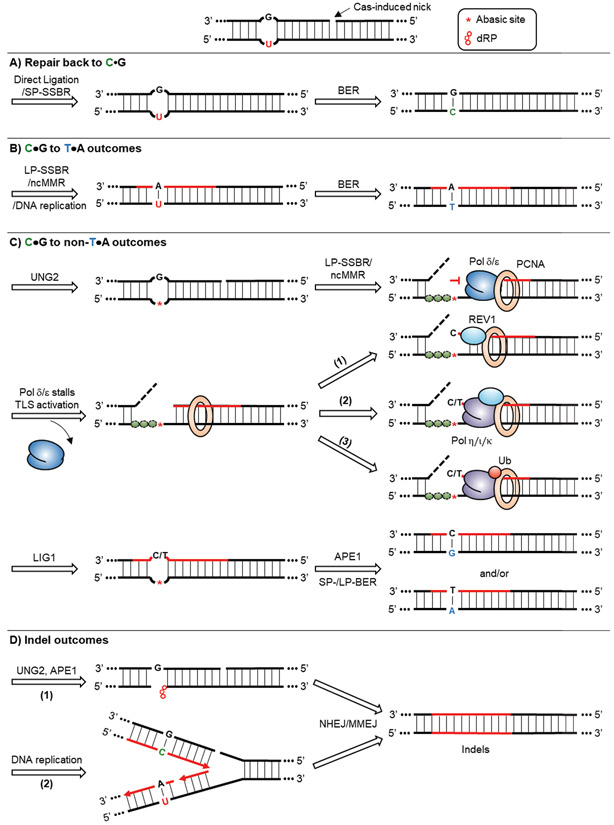Figure 4: CBE outcomes in gDNA.
A typical CBE intermediate features a U•G mismatch accompanied by a 5’ Cas-induced nick. A) The CBE intermediate can be repaired back to C•G by first re-ligation of the nick through SSBR, followed by the deoxyuridine being processed by BER. B) The CBE intermediate can lead to C•G to T•A outcomes when DNA synthesis occurs across the deoxyuridine, which can be achieved by either the LP-SSBR, ncMMR, or normal DNA replication. The resulting U•A base pair can be resolved into a T•A base pair by BER. C) The CBE intermediate can also result in C•G to non-T•A outcomes, which is mediated by DNA synthesis across abasic sites. Abasic sites are generated by excision of uracil by UNG2. DNA synthesis to replace the nicked strand is then carried out by LP-SSBR or ncMMR. Depending on the pathway involved, either an RPA-coated ssDNA gap or a 5’-flap would form, which are depicted by dashed lines. Replicative polymerases Pol δ and Pol ε stall at abasic sites, leading to a subsequent TLS activation to rescue the stalled DNA synthesis and bypass the lesion. There are three potential downstream routes. (1) REV1 is recruited to PCNA. It can insert a dCMP opposite abasic sites. (2) Alternatively, REV1 can recruit other error-prone polymerases, such as Pol η, Pol ι and Pol κ, to the stalled site. They are capable of incorporating both dCMP and dTMP opposite abasic sites. (3) The REV1-independent pathway depends on the recruitment of error-prone polymerases by monoubiquitylation of PCNA. Ligation of the newly synthesized strand by LIG1 forms an intact abasic site-containing intermediate, which is further processed by APE1 and the rest of the BER machinery. This eventually leads to the formation of C•G to G•C and C•G to A•T outcomes. D) The CBE intermediate can be processed into indels, which we attribute to in situ DSB formation. (1) DSBs can arise from processing of deoxyuridine by UNG2 and APE1 before the re-ligation of the Cas-induced nick. (2) DSBs can also be originated from helicase unwinding of the nicked strand during DNA replication. DSB processing by both NHEJ and MMEJ can lead to indels.

